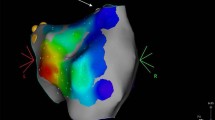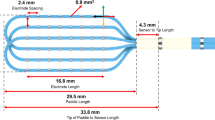Abstract
Atrial tachycardia (AT) is a clinically challenging arrhythmia that can occur based on atrial substrates. Nowadays, a rapid construction of three-dimensional electroanatomical maps, which has an analysis function for complex arrhythmias, named ‘Window Sliding’ (WS) is available. However, little data has revealed the efficacy of this mapping strategy. The aim of this study was to investigate the efficacy of the WS analysis for AT treatments. All patients underwent electrophysiological studies during ATs and the characteristics of the ATs were analyzed using rapid high-density mapping followed by the WS analysis. RFA was then performed. Fifty-five ATs were identified in 34 patients (63 ± 17 year-old) and in 51 activation maps (cycle length, 322 ± 120 milliseconds) were successfully constructed with 644 ± 433 points per map during 5.3 ± 2.5 min. The types of detected ATs were macro-reentries around the mitral (8) and, tricuspid (12) valves, roof-dependent reentry (5), others (13), and focal patterns (13). Of those that underwent RFA, 46 (98%) were treated successfully. Two ATs were abandoned since their critical sites were close to the His bundle and sinoatrial node. During a mean follow-up period of 179 ± 176 days, 7 patients had documented recurrences of AT. This high-density mapping using the WS analysis was useful for creating the entire picture of the ATs in a short time, resulting in favorable RFA outcomes.






Similar content being viewed by others
References
Markowitz SM, Brodman RF, Stein KM, Mittal S, Slotwiner DJ, Iwai S, Das MK, Lerman BB (2002) Lesional tachycardias related to mitral valve surgery. J Am Coll Cardiol 39:1973–1983
Gerstenfeld EP, Callans DJ, Dixit S, Russo AM, Nayak H, Lin D, Pulliam W, Siddique S, Marchlinski FE (2004) Mechanisms of organized left atrial tachycardias occurring after pulmonary vein isolation. Circulation 110:1351–1357
Deisenhofer I, Estner H, Zrenner B, Schreieck J, Weyerbrock S, Hessling G, Scharf K, Karch MR, Schmitt C (2006) Left atrial tachycardia after circumferential pulmonary vein ablation for atrial fibrillation: incidence, electrophysiological characteristics, and results of radiofrequency ablation. Europace 8:573–582
Chugh A, Oral H, Lemola K, Hall B, Cheung P, Good E, Tamirisa K, Han J, Bogun F, Pelosi F Jr, Morady F (2005) Prevalence, mechanisms, and clinical significance of macroreentrant atrial tachycardia during and following left atrial ablation for atrial fibrillation. Heart Rhythm 2:464–471
Rostagno C, Gelsomino S, Capecchi I, Rossi A, Montesi GF, Stefano PL (2016) Factors related to sinus rhythm at discharge after radiofrequency ablation of permanent atrial fibrillation in patients undergoing mitral valve surgery. Heart Vessels 31:593–598
Gerstenfeld EP, Callans DJ, Sauer W, Jacobson J, Marchlinski FE (2005) Reentrant and nonreentrant focal left atrial tachycardias occur after pulmonary vein isolation. Heart Rhythm 2:1195–1202
Patel AM, d’Avila A, Neuzil P, Kim SJ, Mela T, Singh JP, Ruskin JN, Reddy VY (2008) Atrial tachycardia after ablation of persistent atrial fibrillation: identification of the critical isthmus with a combination of multielectrode activation mapping and targeted entrainment mapping. Circ Arrhythm Electrophysiol 1:14–22
Maeda S, Sasaki T, Shirai Y, Ihara K, Kawabata M, Yokoyama Y, Nazarian S, Zimmerman SL, Hirao K (2015) Association of intramural fat deposition in the interatrial septum with focal atrial tachyarrhythmias originating near the atrioventricular node. Heart Vessels 30:143–145
Rostock T, Drewitz I, Steven D, Hoffmann BA, Salukhe TV, Bock K, Servatius H, Aydin MA, Meinertz T, Willems S (2010) Characterization, mapping, and catheter ablation of recurrent atrial tachycardias after stepwise ablation of long-lasting persistent atrial fibrillation. Circ Arrhythm Electrophysiol 3:160–169
Irtel TA, Delacretaz E (2005) Intra-atrial reentrant tachycardia with ambiguous data from activation mapping: what to do next? Heart Rhythm 2:780–781
Castrejon-Castrejon S, Ortega M, Perez-Silva A, Doiny D, Estrada A, Filgueiras D, Lopez-Sendon JL, Merino JL (2011) Organized atrial tachycardias after atrial fibrillation ablation. Cardiology research and practice 2011: 957538
Eitel C, Hindricks G, Dagres N, Sommer P, Piorkowski C (2010) EnSite Velocity cardiac mapping system: a new platform for 3D mapping of cardiac arrhythmias. Expert Rev Med Devices 7:185–192
Ventura R, Rostock T, Klemm HU, Lutomsky B, Demir C, Weiss C, Meinertz T, Willems S (2004) Catheter ablation of common-type atrial flutter guided by three-dimensional right atrial geometry reconstruction and catheter tracking using cutaneous patches: a randomized prospective study. J Cardiovasc Electrophysiol 15:1157–1161
Miyamoto K, Tsuchiya T, Narita S, Yamaguchi T, Nagamoto Y, Ando S, Hayashida K, Tanioka Y, Takahashi N (2009) Bipolar electrogram amplitudes in the left atrium are related to local conduction velocity in patients with atrial fibrillation. Europace 11:1597–1605
Sanders P, Morton JB, Davidson NC, Spence SJ, Vohra JK, Sparks PB, Kalman JM (2003) Electrical remodeling of the atria in congestive heart failure: electrophysiological and electroanatomic mapping in humans. Circulation 108:1461–1468
Lo LW, Tai CT, Lin YJ, Chang SL, Wongcharoen W, Chang SH, Hsieh MH, Tuan TC, Udyavar AR, Chen YJ, Tsao HM, Chen SA (2007) Progressive remodeling of the atrial substrate–a novel finding from consecutive voltage mapping in patients with recurrence of atrial fibrillation after catheter ablation. J Cardiovasc Electrophysiol 18:258–265
De Ponti R, Marazzi R, Zoli L, Caravati F, Ghiringhelli S, Salerno-Uriarte JA (2010) Electroanatomic mapping and ablation of macroreentrant atrial tachycardia: comparison between successfully and unsuccessfully treated cases. J Cardiovasc Electrophysiol 21:155–162
Ju W, Yang B, Chen H, Zhang F, Gu K, Yu J, Li M, Yang G, Cao K, Chen M (2014) Mapping of focal atrial tachycardia with an uninterpretable activation map after extensive atrial ablation: tricks and tips. Circ Arrhythm Electrophysiol 7:598–604
Anter E, Tschabrunn CM, Josephson ME (2015) High-resolution mapping of scar-related atrial arrhythmias using smaller electrodes with closer interelectrode spacing. Circ Arrhythm Electrophysiol 8:537–545
Wo HT, Wen MS, Chang PC, Chou CC, Wang CC, Yeh SJ, Wu D (2014) Successful treatment of macroreentrant atrial tachycardia by radiofrequency ablation targeting channels with continuous activation. Pacing Clin Electrophysiol 37:927–937
Del Carpio Munoz F, Buescher TL, Asirvatham SJ (2010) Three-dimensional mapping of cardiac arrhythmias: what do the colors really mean? Circ Arrhythm Electrophysiol 3:e6–e11
Nakagawa H, Ikeda A, Sharma T, Lazzara R, Jackman WM (2012) Rapid high resolution electroanatomical mapping: evaluation of a new system in a canine atrial linear lesion model. Circ Arrhythm Electrophysiol 5:417–424
Anter E, Tschabrunn CM, Contreras-Valdes FM, Li J, Josephson ME (2015) Pulmonary vein isolation using the Rhythmia mapping system: verification of intracardiac signals using the Orion mini-basket catheter. Heart Rhythm 12:1927–1934
Luther V, Linton NW, Koa-Wing M, Lim PB, Jamil-Copley S, Qureshi N, Ng FS, Hayat S, Whinnett Z, Davies DW, Peters NS, Kanagaratnam P (2016) A Prospective Study of Ripple Mapping in Atrial Tachycardias: A Novel Approach to Interpreting Activation in Low-Voltage Areas. Circ Arrhythm Electrophysiol 9:e003582
Coffey JO, d’Avila A, Dukkipati S, Danik SB, Gangireddy SR, Koruth JS, Miller MA, Sager SJ, Eggert CA, Reddy VY (2013) Catheter ablation of scar-related atypical atrial flutter. Europace 15:414–419
Author information
Authors and Affiliations
Corresponding author
Ethics declarations
Conflict of interest
The authors declare that they have no conflict of interest.
Electronic supplementary material
Below is the link to the electronic supplementary material.
Online Resource 1: The animation that shows actual ‘Window Sliding’ analysis for 3 macro-reentrant atrial tachycardia. After an acquisition of mapping points, the patterns of the color-coding on activation map can be changed by sliding the color bar. The color bar was moved until the white narrow area appeared. Some ATs had multiple narrow white areas, which meant they contained multiple slow conduction zones (MPG 5948 KB)
Rights and permissions
About this article
Cite this article
Nakasuka, K., Miyamoto, K., Noda, T. et al. “Window Sliding” analysis combined with high-density and rapid electroanatomical mapping: its efficacy and the outcome of catheter ablation of atrial tachycardia. Heart Vessels 32, 984–996 (2017). https://doi.org/10.1007/s00380-017-0959-6
Received:
Accepted:
Published:
Issue Date:
DOI: https://doi.org/10.1007/s00380-017-0959-6




